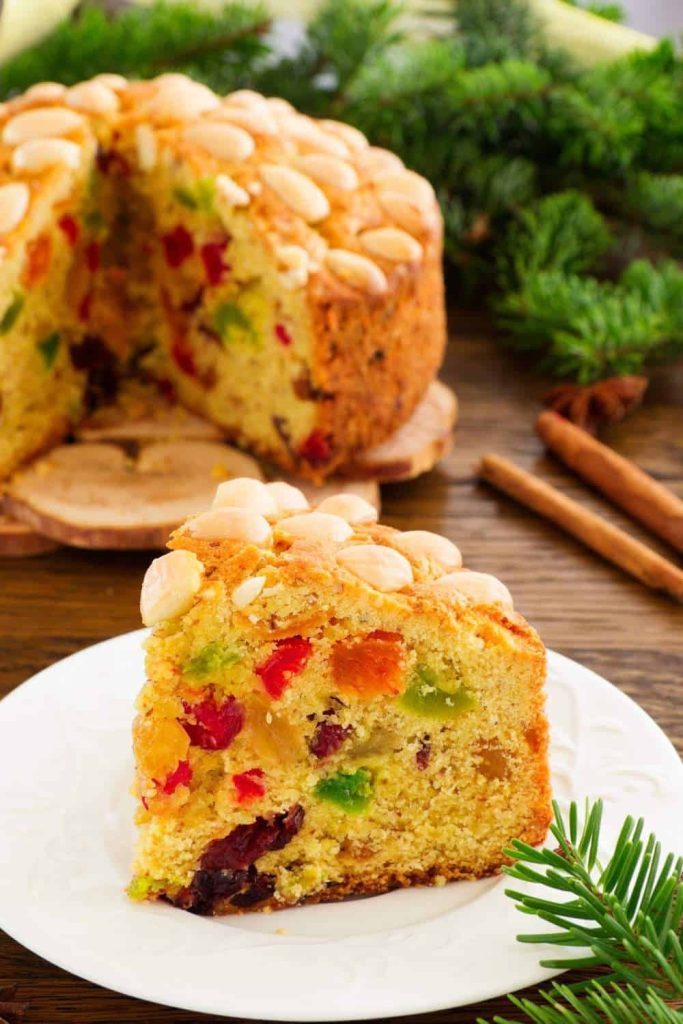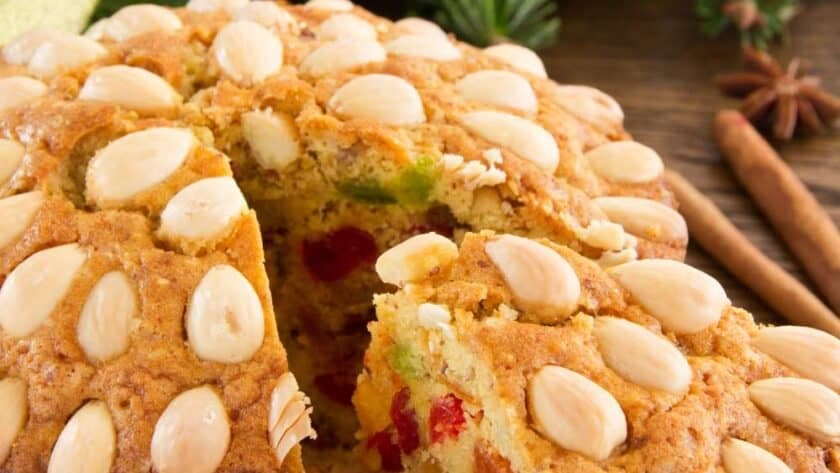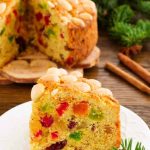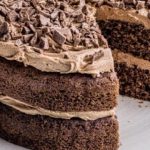Mary Berry’s Dundee Cake is a traditional Scottish fruit cake known for its light texture, rich flavour, and beautiful almond topping. Unlike heavier Christmas fruitcakes, this version is moist but not overly dense, making it perfect for afternoon tea, festive occasions, or simply as a classic bake to enjoy year-round. With dried fruits, citrus zest, and a buttery sponge, it delivers elegance in every slice.
What is Mary Berry Dundee Cake?
Dundee Cake is a famous Scottish fruit cake traditionally flavoured with currants, sultanas, and orange zest, topped with blanched almonds arranged in a circular pattern. Mary Berry’s version keeps the authentic elements while ensuring the cake stays moist, tender, and not too heavy. It’s less rich than a Christmas cake but still full of flavour, making it a versatile bake.

Try Other Mary Berry Cake Recipes
- Mary Berry Date and Walnut Cake
- Mary Berry Seed Cake
- Mary Berry Boiled Fruit Cake
- Mary Berry Lemon Victoria Sponge
Why This Recipe is Worth Trying
- Traditional with elegance – A classic cake with a beautiful almond topping.
- Lighter than Christmas cake – Fruity but not overly rich.
- Perfect for tea time – Pairs wonderfully with a cup of tea or coffee.
- Keeps well – Stays moist for several days.
- Celebration-worthy – Looks impressive without being complicated.
Essential Ingredients to Make Mary Berry Dundee Cake
- 175g butter, softened
- 175g caster sugar
- 3 large eggs
- 200g self-raising flour
- 50g ground almonds
- 250g mixed dried fruit (currants, sultanas, raisins)
- 50g glacé cherries, halved
- 2 tbsp mixed peel
- Zest of 1 orange and 1 lemon
- 2 tbsp milk
- 50g blanched whole almonds (for topping)
Handy Kitchen Tools for Best Results
- 20cm round deep cake tin, lined with baking paper
- Mixing bowls
- Electric whisk or wooden spoon
- Measuring scales
- Cooling rack
Step-by-Step Guide to Making Mary Berry Dundee Cake
Step 1: Prepare the tin
Preheat oven to 160°C (140°C fan). Grease and line a 20cm deep round cake tin.
Step 2: Cream butter and sugar
In a bowl, beat butter and sugar until pale and fluffy.
Step 3: Add eggs gradually
Beat in eggs one at a time, adding a spoonful of flour if the mixture starts to curdle.
Step 4: Fold in dry ingredients
Sift in flour, then fold gently along with ground almonds.
Step 5: Add fruit and zest
Stir in dried fruit, cherries, mixed peel, and citrus zest. Add milk if needed for a dropping consistency.
Step 6: Assemble the cake
Spoon mixture into the prepared tin and level the top. Arrange blanched almonds in neat concentric circles on top.
Step 7: Bake slowly
Bake for 1 hour 40 minutes – 1 hour 50 minutes, or until a skewer comes out clean. Cover with foil if browning too quickly.
Step 8: Cool and serve
Allow cake to cool in the tin for 15 minutes, then transfer to a wire rack.

What I Got Wrong (And How I Fixed It)
- Overloaded with fruit – Made the cake too heavy. Sticking to the recipe gave balance.
- Didn’t arrange almonds neatly – Cake looked messy. Taking time to line them up improved the presentation.
- Baked at too high a heat – Caused burning. Lower oven temperature ensured even baking.
Healthier Ways to Make Mary Berry Dundee Cake
- Reduce sugar slightly, as dried fruit provides sweetness.
- Replace butter with a light spread or part oil.
- Use wholemeal flour for extra fibre.
- Add chopped dried apricots or figs for natural sweetness.
Ingredient Substitutions for Mary Berry Dundee Cake
- Mixed fruit → Use just currants and raisins if preferred.
- Ground almonds → Replace with extra flour if needed.
- Orange and lemon zest → Try lime zest for a fresh twist.
- Almond topping → Swap with pecans or walnuts.
Pairing Ideas: What to Serve With Mary Berry Dundee Cake
- Cup of tea or coffee – Classic pairing.
- Clotted cream – Adds indulgence.
- Custard or pouring cream – Turns it into a dessert.
- Fresh berries – Lightens the richness.
- Whipped cream – Soft and simple.
Expert Tips to Make Mary Berry Dundee Cake
- Arrange almonds neatly – Gives the cake its iconic look.
- Weigh fruit accurately – Prevents heaviness.
- Bake slowly – Low oven temperature stops burning.
- Check with a skewer – Ensures the cake is fully baked.
- Cool in the tin – Prevents crumbling.
- Wrap to store – Keeps the cake moist for days.
Creative Ways to Customize Mary Berry Dundee Cake
- Add a splash of whisky for a Scottish twist.
- Use dried cranberries for a festive touch.
- Drizzle with a citrus glaze for extra flavour.
- Mix in dark chocolate chips for indulgence.
- Top with a honey glaze for shine.
Storing Mary Berry Dundee Cake the Right Way
- Wrap in foil and store in an airtight container for up to 1 week.
- Refrigerate if warm weather shortens shelf life.
- Freeze slices individually for up to 2 months.
How to Reheat Mary Berry Dundee Cake
- Oven method – Warm at 150°C for 10 minutes.
- Microwave method – Heat slices for 15–20 seconds.
- From frozen – Defrost overnight before reheating.
Nutritional Breakdown (per serving)
- Calories: ~390 kcal
- Protein: 7g
- Carbohydrates: 52g
- Fat: 18g
- Fibre: 3g
- Sugar: 32g
Mary Berry Dundee Cake Recipe
Dundee Cake is a famous Scottish fruit cake traditionally flavoured with currants, sultanas, and orange zest, topped with blanched almonds arranged in a circular pattern. Mary Berry’s version keeps the authentic elements while ensuring the cake stays moist, tender, and not too heavy. It’s less rich than a Christmas cake but still full of flavour, making it a versatile bake.
- Prep Time: 25
- Cook Time: 105
- Total Time: 2 hours 10 minutes
- Yield: 10 1x
- Category: Dessert
- Method: Baking
- Cuisine: Scottish
Ingredients
-
175g butter, softened
-
175g caster sugar
-
3 large eggs
-
200g self-raising flour
-
50g ground almonds
-
250g mixed dried fruit (currants, sultanas, raisins)
-
50g glacé cherries, halved
-
2 tbsp mixed peel
-
Zest of 1 orange and 1 lemon
-
2 tbsp milk
-
50g blanched whole almonds (for topping)
Instructions
Preheat oven to 160°C (140°C fan). Grease and line a 20cm deep round cake tin.
In a bowl, beat butter and sugar until pale and fluffy.
Beat in eggs one at a time, adding a spoonful of flour if the mixture starts to curdle.
Sift in flour, then fold gently along with ground almonds.
Stir in dried fruit, cherries, mixed peel, and citrus zest. Add milk if needed for a dropping consistency.
Spoon mixture into the prepared tin and level the top. Arrange blanched almonds in neat concentric circles on top.
Bake for 1 hour 40 minutes – 1 hour 50 minutes, or until a skewer comes out clean. Cover with foil if browning too quickly.
Allow cake to cool in the tin for 15 minutes, then transfer to a wire rack.
FAQs
How do you stop fruit from sinking in a Dundee cake?
To stop fruit from sinking, toss dried fruit in a little flour before folding into the batter. Ensuring the batter has the right dropping consistency also helps keep fruit evenly distributed.
Should Dundee cake be soaked in alcohol?
Traditional Dundee cake is lighter than Christmas cake and not usually soaked in alcohol. However, you can add a splash of whisky or brandy to the batter for extra flavour if desired.
How do you know when Dundee cake is fully baked?
Dundee cake is ready when it’s golden brown and a skewer inserted into the centre comes out clean. If the top browns too quickly, cover with foil while the inside finishes baking.
Do you need to line the tin for Dundee cake?
Yes, lining the tin with baking paper helps prevent the cake from sticking and protects the edges from over-browning during the long baking time.
Wrapping It Up
Mary Berry’s Dundee Cake is a beautifully simple yet elegant bake, perfect for special occasions or an afternoon tea treat. With its light sponge, rich fruit, and traditional almond topping, this Scottish classic delivers flavour and tradition in every slice. A recipe worth keeping, it’s a cake that celebrates timeless baking at its best.




